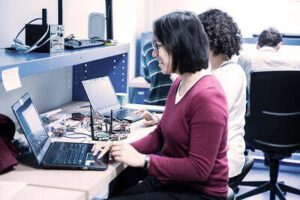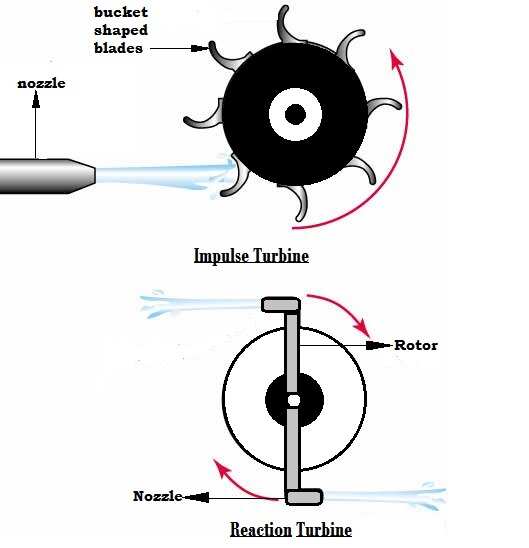Internet of Things Definition, History, Types, Components, Benefits
Internet of things is the term used to describe technological integrated systems where various data-controlled digital devices collaborate seamlessly in real-time. This article discusses internet of things definition, working principle, history, types, components and benefits, as outlined below;
-Internet of Things Definition: 5 Ways to Define Internet of Things
Internet of Things Definition: 5 Ways to Define Internet of Things
Internet of things (IoT) is an interconnected system that comprises of multiple smart devices which are actively sharing and utilizing data for the performance of individual and collective functions [4].
Because it includes smart devices and their interconnections, internet of things is in fact a collaboration of diverse digital technologies in wireless communication, computing, artificial intelligence, machine learning, deep learning and neural network applications, that are unified such that they become an integrated unit.
In further effort to clarify the above point, below is an alternative internet of things definition that highlights some applications of IoT;
Internet of things is an integrated system of smart devices that are seamlessly interconnected, and utilized for applications like; sustainable building maintenance, data management, sustainable agriculture, manufacturing, and support of smart grid infrastructure [5].

Some examples of internet of things are listed in the following internet of things definition;
Internet of things refers to the connection, assembly and collaborative operations of various smart computing devices which share data and improve the efficiency of their collective output, examples of which are; electric car-to-grid, smart irrigation systems, smart grid networks, industrial automation infrastructure, and smart home systems.
The next internet of things definition mentions some advantages of internet of things;
Internet of things can be defined as a system, infrastructure and mode of operation whereby multiple smart devices are seamlessly connected to each other, and perform tasks collaboratively, with advantages such as; energy conservation, high efficiency, low labor demand, increased flexibility and versatile functionality [1].
Lastly, some disadvantages of internet of things are listed in the IoT definition as follows;
Internet of things is a technological concept concerned with the features, design and use of interconnected digital systems, and which faces some drawbacks like complexity, cost, and data security [3].
How IoT Works
Internet of things works (IoT) works by a three-step process of interconnection, data management, and function optimization.
1). Interconnection (in explanation of How IoT Works)
Interconnection is the first step in the working process or principle of IoT.
In order for the devices that make of an IoT system to work together, they must first be seamlessly connected to each other. This is achieved using wireless technologies like Wi-Fi.
2). Data Management
After the smart devices in an IoT system have been seamlessly connected, they begin to collect, analyze, process, share and utilize data in real time. This is generally known as data management.
For example, a smart irrigation IoT system comprises of sensors that collect data on soil moisture and other environmental parameters [8]. These data are analyzed and processed, and the resulting information is shared with other components of the irrigation system that utilize it in order to make decisions and perform functions.
3). Function Optimization (in explanation of How IoT Works)
Function optimization refers to the outcome of collaborative operations between smart devices in an IoT system, whereby the functions of each device become optimized or improved as a result.
History of IoT
The history of IoT can be traced as far back as the nineteenth century, with efforts to develop wireless transmission technology, was first put into practice in 1900 with the first wireless voice transmission on radio [10].
Database and internet technologies had their early development in the 1960s to 1980s, with projects and agencies like the ARPANET (Advanced Research Projects Agency Network).
Development of infrastructure for IoT implementation is based on events like the invention of multi-chip microprocessors in 1969, and the single-chip microprocessor which was released in 1971 by Marcian Hoff, Masatoshi Shima, and Stan Mazor [2].
Space exploration, geospatial data management, and global positioning satellite (GPS) development are other factors that built the foundation of IoT in the 1980s and 1990s.
While other small IoT projects were executed within the period mentioned above, no definite description was given to these projects until 1999, when MIT technologist Kevin Ashton coined the term Internet of Things [7].
There is no precise pointer as to who invented the first IoT system, or where it was invented, as there were several integrated data-based models developed in the early days of digital technology.
However, some events are often referred to when discussing the invention of IoT; such as a Coca-Cola vending machine data-collection setup that was created in 1982 by students at the Carnegie Melon University in order to monitor the contents of the machine [9], and a wireless-controlled toaster created by John Romkey in 1990 [6].
Twenty-first century developments in the field of IoT have spanned across construction, agriculture, electric cars, smart grids, power plants, and sustainable manufacturing. These developments have been pioneered by technological companies, and facilitated by efforts to achieve sustainability.
Types of IoT
Based on application, the types of IoT are;
1). Consumer IoT
2). Industrial IoT
Other types of IoT are named in some studies, based on specific context. These include;
3). Military IoT (MIoT)
4). Commercial IoT
5). Infrastructure IoT
Components of IoT Systems
Components of IoT systems are;
1). Internet
2). Connectivity medium like Wi-Fi
3). 'Things' which refer to smart devices like sensors
4). Data management framework, including collection, analysis, sharing, security
5). User interface
Benefits of IoT
Benefits of IoT are;
1). Versatile application
2). Increase in productivity
3). Efficient data management
4). Facilitation of economic growth
5). Reduction of labor demand
6). Resource conservation
Groups that benefit the most from IoT include manufacturing, energy management, and corporate sectors; as well as smart residential building-users.
Conclusion
Internet of things is a concept, system and function that is comprised of seamlessly integrated smart devices, data, user interface, and applications.
IoT works in two stages which are;
1. Interconnection
2. Data Management
Types of IoT are; consumer, industrial, military, commercial, and infrastructure IoT.
Components of IoT systems are; internet, connectivity media, devices, data management framework, and user interface.
Benefits of IoT are; versatile application, increased productivity, efficient data management, economic growth facilitation, reduced labor demand, and resource conservation.
References
1). Bedi, G.; Venayagamoorthy, G. K.; Singh, R.; Brooks, R.; Apon, A. W. (2018). "Internet of Things and Intelligent Technologies for Efficient Energy Management in a Smart Building Environment." Doctor of Philosophy (PhD) Thesis. Available at: https://www.researchgate.net/publication/339389960_Internet_of_Things_and_Intelligent_Technologies_for_Efficient_Energy_Management_in_a_Smart_Building_Environment. (Accessed 18 January 2023).
2). Hoff, M. (1996). "The history of the 4004." Available at: https://www.academia.edu/81563972/The_history_of_the_4004?f_ri=263076. (Accessed 18 January 2023).
3). Kevin, F; Kohno, T.; Lopresti, D.; Mynatt, E.; Nahrstedt, K.; Patel, S.; Richardson, D.; Zorn, B. (2020). "Safety, Security, and Privacy Threats Posed by Accelerating Trends in the Internet of Things." Available at: https://www.semanticscholar.org/paper/Safety%2C-Security%2C-and-Privacy-Threats-Posed-by-in-Fu-Kohno/49552619facd570a34becd8e3fa41d5f99da10e2#related-papers. (Accessed.18 January 2023).
4). Patel, K.K.; Patel, S.; Salazar, C. (2016). "Internet of Things-IOT: Definition, Characteristics, Architecture, Enabling Technologies, Application & Future Challenges." Available at: https://www.semanticscholar.org/paper/Internet-of-Things-IOT-%3A-Definition-%2C-%2C-%2C-Enabling-Patel-Patel/dd89eb44fb82d553432927c8083442edabdebfee. (Accessed 18 January 2023).
5). Rana, M.; Xiang, W.; Wang, E.; Jia, M. (2017). "IoT Infrastructure and Potential Application to Smart Grid Communications." GLOBECOM 2017 - 2017 IEEE Global Communications Conference. Available at: https://doi.org/10.1109/GLOCOM.2017.8254511. (Accessed 18 January 2023).
6). Romkey, J. (2017). "Toast of the IoT: The 1990 Interop Internet Toaster." IEEE Consumer Electronics Magazine 6(1):116-119. Available at: https://doi.org/10.1109/MCE.2016.2614740. (Accessed 18 January 2023).
7). Tripathy, B. K.; Anuradha, J. (2017). "Internet of Things(IoT): Technologies, Applications, Challenges and Solutions." CRC Press, Taylor and Francis, ISBN: 9781315269849. Available at: https://www.researchgate.net/publication/320445442_Internet_of_ThingsIoT_Technologies_Applications_Challenges_and_Solutions. (Accessed 18 January 2023).
8). Velmurugan, S.; Balaji, V.; Bharathi, T. M.; Saravanan, K.; Head, H. (2020). "An IOT based Smart Irrigation System using Soil Moisture and Weather Prediction." IJERT - ECLECTIC 2K20, TJS Engineering College, Volume: 8. Available at: https://papers.ssrn.com/sol3/papers.cfm?abstract_id=3597146. (Accessed 18 January 2023).
9). Verma, D. K.; Slaman, U.; Samant, V. (2019). "An Application Perspective of IoT." Available at: https://www.researchgate.net/publication/333555551_An_Application_Perspective_of_IoT. (Accessed 18 January 2023).
10). Wicks, A.; Kemerling, J. (2003). "A brief early history of wireless technology." Experimental Techniques 27(6):57-58. Available at: https://doi.org/10.1111/j.1747-1567.2003.tb00140.x. (Accessed 18 January 2023).

